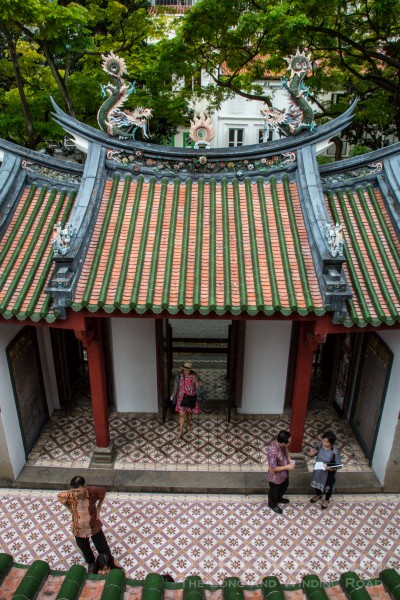A curious sight found at one of Telok Ayer Street’s two beautifully restored mid-19th century Chinese pagodas, the Chung-Wen pagoda or Chong-Wen Ge (崇文阁), are eight figures that are seen propping up the pagoda’stop tier. Referred to rather disparagingly in colloquial Hokkien as “dim-witted foreigners”, these figures carved from wood have no structural function and are purely decorative features. Similar figures, which are also sometimes made of clay, are apparently quite commonly used in Minnan architecture. The practice is thought to have their origins in the Tang Dynasty, when they were said to have been used to commemorate the efforts of foreign labourers who were often involved in building projects.

The Chung Wen Pagoda.

Support beams for the uppermost tier of the pagoda, which feature carvings of non-Chinese men depicted as lending support to the structure.

A night-time view of the pagoda.
The eight wooden cravings are just some of an amazing array of decorative work found in the incredibly beautiful pagoda. Built between 1849 and 1852, the pagoda, besides it features that define a strong Chinese flavour, also has features that speak of the influences present in the 18th century Singapore such as a wrought iron sprial staircase that was put in during a restoration effort in 1880 and encaustic floor tiles, which can also be found in other Chinese buildings in the country.

Decorative details.

The second tier.

The reverse view.

The wrought iron staircase.
Linked with the Hokkien community, whose spiritual centre was at the next door Thian Hock Keng temple, the Chung-Wen pagoda apparently also had the support of other groups within the wider Chinese community. This is evident in one of three steles found on the site. The stele, which commemorates the pagoda’s construction, sees the names of Teochew leader Seah Eu Chin as well as that of a Hakka, Liew Lok Teck, alongside names associated such as Tan Kim Seng, Ang Choon Seng, Wee Chong Sun and Cheang Sam Teo from the Hokkien community.

The stele commemorating its construction.

A view of the entrance doorway to the Chong-wen Ge from the upper tier of the pagoda.
We also see on the stele that a shrine dedicated to Zitong Dijun (梓潼帝君) was placed on the pagoda’s second tier. Zitong Dijun, also known as Wenchang (文昌), is considered to be the Chinese god of culture and literature, and is a patron deity of scholars. This is a clear indication of the Chung-Wen pagoda’s intended purpose as a place given to promoting learning, although not all experts agree on the manner in which it was done. What is clear however, is that the Chong-Wen Ge was where the written word was venerated. This was carried out through the practice of the burning of papers on which words have been written, in honour of the inventor of Chinese characters, Cangjie (倉頡). The installation of a small paper burning pagoda on the site for this purpose is also recorded on the stele.

Old world gods now surrounded by the gods of the new world – a view from the pagoda across to the Thain Hock Keng and the former Keng Teck Whay and the financial centre of the city beyond it.

The building which housed the Chong Hock School.
The practice of burning the written word ended in 1910 when the trustees of the Chong-Wen Ge handed control of it over to the Thian Hock Keng temple, although it can be said that the written word was then celebrated in a different manner with the founding of the Chong Hock School for girls in 1915. The school operated in the simple but lovely two storey building adjacent to the pagoda and only moved out in 1985 as Chongfu School. The school’s building have seen several uses since and now houses the Singapore Musical Box Museum on its upper level. An encaustic tile shop and a Peranakan café is also now found on its ground level.

A view of the Chong Hock School building from the pagoda.
The Chong-Wen Ge, which translates as the Institute for the Veneration of Literature, was gazetted as a National Monument in 1973 with the Thian Hock Keng. Its wonderfully restored state is the result of its last major restoration effort which was undertaken between 2001-2003. More information on it and other conserved former school buildings can be found in a URA Heritage Schools Pamphlet.

Decorative detail on a door on the pagoda’s second level.

A view from Telok Ayer Street.

A view from the cafe.
A close-up of the eight “dim-witted foreigners”












































































